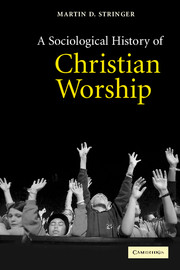Book contents
- Frontmatter
- Contents
- Preface and acknowledgements
- Introduction: Discourse, devotion and embodiment
- 1 Early Christian worship, texts and contexts to ad 300
- 2 Worship and the Christianisation of public space, 300–600
- 3 Hegemonic discourses in the worship of empires, 600–900
- 4 The dominant discourse of cosmological Christianity, 900–1200
- 5 Accessing the demotic discourses of devotion, 1200–1500
- 6 Worship and the rise of humanistic discourses, 1500–1800
- 7 The globalisation of Christian worship, 1800–2000
- Bibliography
- Index
3 - Hegemonic discourses in the worship of empires, 600–900
Published online by Cambridge University Press: 03 December 2009
- Frontmatter
- Contents
- Preface and acknowledgements
- Introduction: Discourse, devotion and embodiment
- 1 Early Christian worship, texts and contexts to ad 300
- 2 Worship and the Christianisation of public space, 300–600
- 3 Hegemonic discourses in the worship of empires, 600–900
- 4 The dominant discourse of cosmological Christianity, 900–1200
- 5 Accessing the demotic discourses of devotion, 1200–1500
- 6 Worship and the rise of humanistic discourses, 1500–1800
- 7 The globalisation of Christian worship, 1800–2000
- Bibliography
- Index
Summary
INTRODUCTION: HEGEMONY
In the previous chapter I suggested that the process of Christianisation was a slow and gradual movement developed through the individual actions of many different people, and that it represented a gradual change in the direction of discourses within the society as a whole. As we will see in Chapter 5, however, there are many conflicting worldviews vying for a place within the discourses of all complex societies. Over against this complete and widespread view of Christianisation there were clearly other forces at work that had an equally important impact on the development of Christian worship. While much of the process discussed in the previous chapter could be described as bottom-up (at least in principle) there were also top-down movements that involved the imposition of Christian ideas and practices as part of state policy. In the period between about 600 and 900 this involved attempts by ruling authorities to manipulate and control liturgy for political ends. It is these attempts, and their consequences for the development of Christian worship, that I wish to explore in this chapter.
It is difficult to define exactly how a particular state establishes and maintains its authority. There are many theories within the political sciences from Machiavelli to Gramsci and beyond. No one theory could ever be used in isolation to explain every single instance.
- Type
- Chapter
- Information
- A Sociological History of Christian Worship , pp. 89 - 119Publisher: Cambridge University PressPrint publication year: 2005



